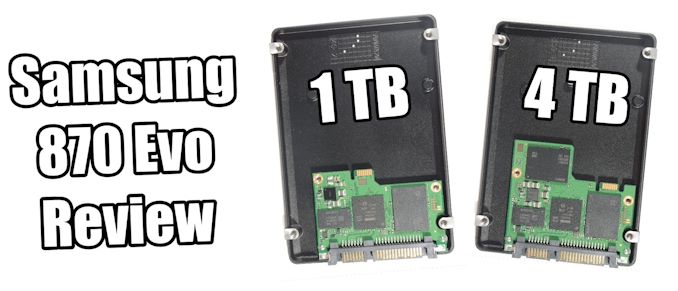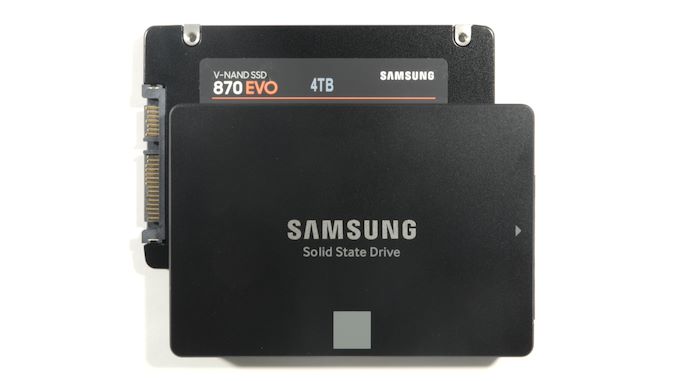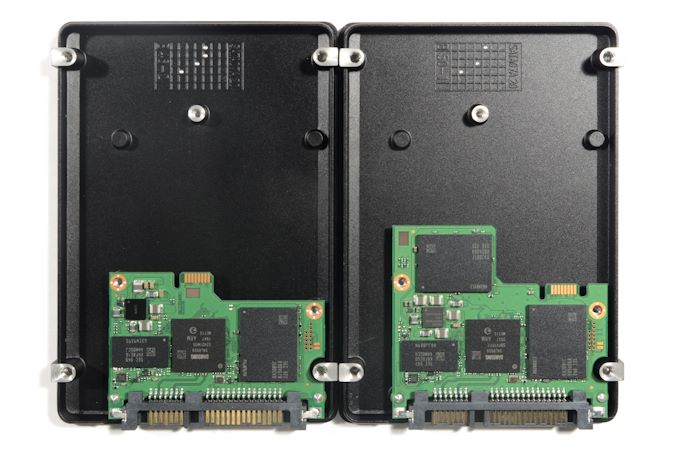The Samsung 870 EVO (1TB & 4TB) Review: Does the World Need Premium SATA SSDs?
by Billy Tallis on February 17, 2021 8:00 AM EST
Samsung has dominated the SSD market for a very long time, and every new consumer SSD model the company introduces is noteworthy. The latest product to reach the shelves is the new range of 870 EVO SSDs, building on a decade-long legacy of SATA SSDs. We have tested the 1 TB and 4 TB models from this new product family.
Pushing for SATA
Samsung is one of the few companies still putting significant effort into SATA SSDs and releasing new consumer SATA models. As PC OEMs have overwhelmingly switched to using NVMe SSDs in new systems, even on the smaller capacities, the client/consumer SATA SSD market now exists almost entirely for the sake of DIY system builders and aftermarket upgrades on older systems. Most major consumer SSD brands have either stopped updating their SATA models, or decided to quietly update components without the fanfare of a new model release. Then there are companies creating odd-ball models, such as a 15.36 TB design. Either way, we don't get many new consumer SATA SSDs in for review these days.
(It is worth noting that the enterprise SATA SSD market has seen somewhat more in the way of visible activity, because the longer product lifetimes in that market and the higher profit margins give SATA SSDs more of a long tail of commercial relevance.)
Despite this market shift, Samsung is still focused on a SATA product line, although even Samsung is showing reduced interest in SATA. It took over six months from the release of the QLC-based 870 QVO for its TLC-based 870 EVO sibling to arrive, and there's still no sign of an MLC-based 870 PRO model (or any other MLC SSDs from Samsung based on anything newer than their 64-layer 3D NAND). Furthermore, the new 870 EVO no longer caters to either mSATA and M.2 SATA form factors, focusing solely on 2.5-inch drives. The mSATA version of the 860 EVO disappeared from the market last year, but the M.2 SATA version is still readily available and has tracked market price trends as much as Samsung's drives ever do. It's a bit of a surprise that they're dropping M.2 SATA this soon given how long Samsung supported mSATA.
Given the roughly three-year cadence Samsung has set for their SATA SSD updates, the 870 generation may also be the last.
| Samsung 870 EVO Specifications | |||||||
| Capacity | 250 GB | 500 GB | 1 TB | 2 TB | 4 TB | ||
| Form Factor | 2.5" 7mm SATA | ||||||
| Controller | Samsung MKX | ||||||
| NAND Flash | Samsung 512Gbit 128L 3D TLC | ||||||
| LPDDR4 DRAM | 512MB | 1 GB | 2 GB | 4 GB | |||
| Sequential Read | 560 MB/s | ||||||
| Sequential Write |
SLC | 530 MB/s | |||||
| TLC | 300 MB/s | 530 MB/s | |||||
| Random Read |
QD32 | 98k IOPS | |||||
| QD1 | 13k IOPS | ||||||
| Random Write |
QD32 | 88k IOPS | |||||
| QD1 | 36k IOPS | ||||||
| Power Draw |
Burst | 3.5 W | 4.0 W | 4.5 W | 5.0 W | ||
| Average | 2.2 W | 2.5 W | |||||
| Idle | 30 mW | 35 mW | |||||
| Warranty | 5 years | ||||||
| Write Endurance | 150 TB 0.3 DWPD |
300 TB 0.3 DWPD |
600 TB 0.3 DWPD |
1200 TB 0.3 DWPD |
2400 TB 0.3 DWPD |
||
| Launch MSRP | $39.99 (16¢/GB) |
$69.99 (14¢/GB) |
$129.99 (13¢/GB) |
$249.99 (12¢/GB) |
$479.99 (12¢/GB) |
||
We are seeing the usual upgrades in the spec table for the 870 EVO compared to the 860 EVO from 2018. The controller is now Samsung's MKX, a minor iterative update to the 860's MJX. The NAND flash memory is a more significant jump: the 870 EVO is using Samsung's 128-layer 3D TLC, first seen on the 980 PRO. More specifically, our 1TB and 4TB 870 EVO samples are using the 512Gbit dies that were introduced on the 2TB 980 PRO, a model that arrived much later than the smaller capacities built around 256Gbit dies. The preceding Samsung 860 EVO launched with Samsung's 64L 3D NAND, and they appear to have skipped over their 92L generation with their TLC SATA drives.
The performance specifications are very similar to the 860 EVO. Almost all of those performance numbers are limited either by the throughput of the SATA interface or the latency of the NAND itself, so most of the performance numbers are the same across the entire capacity range. The 250GB and 500GB models still have significantly lower sequential write speed after the SLC cache runs out, but this time we don't have official numbers on SLC cache sizes (but we have tested that in this review). On the other hand, Samsung continues to be one of the few brands to provide performance specifications for queue depth 1 in addition to the high queue depth ratings.
Internally, the 870 EVO continues to illustrate just how ridiculously oversized the 2.5" form factor is for modern consumer storage. Even the 4TB model's PCB takes up just a fraction of the internal space, and the 1TB model's even smaller PCB has only a handful of tiny components for the power regulation on its back side—this could have easily been a single-sided board if Samsung wasn't saving space for the extra flash on the 2TB model.
The SATA Competition: Hard to Determine
Truth be told, there aren't that many new SATA SSDs on the market. To put this into perspective, the most recent SATA competitor we reviewed, the SK hynix's Gold S31, was launched in 2019.
Part of this is down to the lack of focus on the SATA market as mentioned above, but also because SSD vendors have taken to silently updating the hardware inside a product line without changing the product number or announcing the change. Their argument is that as long as they can still achieve the same performance listed in the specification sheet, and adhere to the warranty, the customer shouldn't have to worry about what is actually inside the product.
We generally disapprove when SSD vendors silently swap out major components without renaming a product, because changing the SSD controller or NAND flash can have a major impact on a drive's performance and power efficiency. Unfortunately, this has long been a common practice for entry-level models, and a few manufacturers have tried it on more upmarket models and been deservedly excoriated when they're caught (eg. ADATA, with the SX8200 Pro).
However, for mainstream SATA SSDs based on TLC NAND and controllers with DRAM caches, there's a lot less potential downside for consumers when the manufacturer silently upgrades the NAND. The SATA interface imposes such a severe performance bottleneck that it's unlikely new NAND would result in a slower drive. Switching to newer NAND with a higher per-die capacity could adversely affect the smallest models in a product line, but the tendency has been for 120GB models to simply disappear instead of being updated—and they aren't missed. We're disappointed that (for example) Micron's Crucial MX500 is now shipping with at least 96-layer NAND rather than the 64-layer NAND it launched with, and likely with Silicon Motion's SM2259 controller that features improved error correction over the SM2258.
Newer NAND in existing SATA models is far more likely to bring benefits to consumers. Maximum throughput cannot increase, but latency and performance at lower queue depths can still be improved marginally. Newer NAND also tends to bring power efficiency improvements, which means that upgrading the storage capacity in a laptop that's a few years old shouldn't hurt battery life even though larger drives tend to be more power-hungry.
The other factor in this is that we recently updated our SSD test suite for 2021, which means re-testing older drives for new performance numbers. In our SSD test suite 2021 article, we prioritized NVMe SSDs, as that is where the market is. We are getting around to retesting the older SATA drives, although these take the longest time to complete - 24 hours for a fast 1 TB drive, up to 100 hours or more for a 4 TB drive, not including the analysis.
So while we're a bit lacking in SATA review samples that reflect the current state of the market, we do have a diverse selection of entry-level NVMe SSDs that have been pushing into the SATA SSD price bracket. These may not be viable alternatives for some use cases (older systems that don't support NVMe, or data hoarders that need lots of multi-TB drives), but for any reasonably recent consumer system with ordinary storage needs, these NVMe drives are real competitors to SATA SSDs. That's the focus on this review.

















136 Comments
View All Comments
hansmuff - Wednesday, February 17, 2021 - link
Especially the 4TB seems like a fantastic Games drive to me, really good performance at a great price.ekon - Wednesday, February 17, 2021 - link
What (my) world needs is an absolutely rubbish but cheap high capacity SSD. As many cell levels as it takes.jarablue - Wednesday, February 17, 2021 - link
I have 2 sata WD Blue 1 tb ssds for game installs. They work totally fine and load games fast as hell. SATA ssds are still on point for large game storage space.Spunjji - Friday, February 19, 2021 - link
It'll be interesting to see if this changes along with software being developed for the new generation of consoles.Duncan Macdonald - Thursday, February 18, 2021 - link
It takes 10 gig ethernet to exceed the speed of SATA - the SATA limit of 600 MBytes/sec is 4800Mbits/sec - allowing for TCP/IP overhead even a 5GbE link can not carry data as fast as a SATA link.SATA is still the only effective way of increasing the internal storage of systems that have no free NVMe slots available.
Tomatotech - Thursday, February 18, 2021 - link
Or a USB3 / USB-C drive taped / velcro’d somewhere in the PC case.Could contain either 2.5” HDD, or 2.5” SDD or a m.2 NVME SSD in a USB enclosure. I’ve done that a couple of times with small cases. Works perfectly fine especially with solid state media.
edzieba - Thursday, February 18, 2021 - link
Cable-attached storage still has the massive advantage that you can connect more drives than you have board area for. A regular motherboard may have one m.2 slot, paying out the nose may net you two slots. Selling off a few organs may buy a halo board with 3 or more slots. Or you may need a bloated riser card and occupy as 16x slot (no go for ITX). Or... you can use the at least 4 SATA ports on even the most bargain basement board (with 8 being hardly uncommon) to stuff more capacity in as needed with ease.SATA Express was the right idea at the wrong time: a x1 or x2 PCIe interface to allow NVMe, with PHY fallback to SATA, and at entirely acceptable bandwidth for most uses (stick in an m.2 boot drive for OS and key applications) would be a perfect upgrade path for consumer SATA use. If it integrated power transport too (for SSD only, block mechanical drives with keying at the device end cable) it would simplify cable routing too. But that boat has probably sailed for good, unless enterprise just happens to adopt such a connector and drive architecture, which seems unlikely with density demands ever increasing. I don't think we'll see any new internal high bandwidth cabling standards other than PCIe link rate updates to the persistently high-priced OCuLink.
Tomatotech - Thursday, February 18, 2021 - link
For more internal storage, a USB3 / USB-C drive can be taped / velcro’d somewhere in the PC case.Could contain either 2.5” HDD, or 2.5” SDD or a m.2 NVME SSD in a USB enclosure. I’ve done that a couple of times with small cases. Works perfectly fine especially with solid state media.
abufrejoval - Thursday, February 18, 2021 - link
I remember experimenting with Compact Flash cards on PCMCIA and IDE adapters, trying to run Windows XP and Linux on them: Sure, there were no seeks, but at the time I didn’t understand the erase block issues yet and was just befuddled how some I/O just seemed so slow it had XP crash.When FusionIO came out with their first devices, I jumped on those and they were basically a precursor of NVMe, ouch, is it 13 years already?
I’ve celebrated SATA SSDs, still have a 160GB Postville under current in a firewall, that may last another 10 years. I lost count, but there may be 30-50 SATA SSD in the house, some still used as „boot stick“ with only 128GB, most 1/4 to 1TB, some with 2TB.
The only 4TB SSD here is actually a RAID-0 using 4x1TB, because I tend to have plenty of SATA ports left over in all these tower chassis, that used to house 3.5“ HDDs. The last system with 2.4 TB FusionIO card also still sports 4x 200GB Intel enterprise DC3700 MLC drives, just because that X99 board has 10 SATA ports, so why not use them in a RAID so vastly overprovisioned that it will never die?
Like those ancient HDDs, these SSDs move around between boxes, almost like the „Winchesters“ or removable hard disks in the old days (been around since PDP-11/34). I use carrier-less hot swap bays on all systems, SATA caddies on laptops or USB3/SATA cases, for their flexibility: Milliseconds saved on storage benchmarks don’t compare to productivty and not having to disassemble a workstation with a 3 slot GPU and giant fans for low-noise, just to switch to another OS is a real bonus!
Most of the time SATA-SSD really is quite simply fast enough. If not, it’s the architecture, stupid!
And some of the more agonizing waits, turn out to be not at all related to SATA vs. NVMe…
ARK Survival Evolved is one of my favorite games, because I play that with my kids. Its main downside is loading-time: It just takes ages and ages to launch! Sure, it has 200GB data with all these extra maps and extensions, but perhaps more importantly, it’s 100.ooo files.
I got really tired of waiting for those minutes it took to load that from HDDs, so I invested in one of those „giant“ 1TB (SATA) SSDs at the time… still took awhile to load, but the improvement was significant (less than one CMU or coffee mug unit). Now, since we all play the game, I tried to be smart and put it on the network in the 4TB JBOD/RAID0 I mentioned, and then upgraded to a 10Gbit network to match the performance.
Alas, the load times across the 10Gbit network were horrific! Far worse, than the single 2TB HDD I had used in the beginning.
Then one day I ran ARK on Linux, within a larger experiment on the quality of Linux gaming. I didn’t have a big enough SSD around to store the game data, so instead I used one of those 2TB -WD HDD hunks from 15 years back, that just refuse to fail.
And then I almost fell of my chair, when ARK launched faster off that HDD than I had ever even see it launch from an NVMe drive (yes, of course, I had to have some of those, too).
Long story slightly abbreviated, the annoyingly slow ARK launches were never a storage issue, but a Windows file access overhead issue. Linux truly put Windows to shame that day! It managed to load those tens of thousands of files ARK required much faster from a HDD, than Windows needed on NVMe storage, and way, way, WAY faster than Windows (10Gbit) networking from a SATA-SSD RAID0.
Now, Windows and Windows 10Gbit networking isn’t always and by-default orders of magnitude slower than Linux. At least not, when you’re dealing with a few large files. But when your game (or application) happens to use 100.ooo small files instead of 10 big ones, be advised to test the OS before you blame it on the storage!
The general protocol and latency overhead of SATA vs. (PCIe)NVMe is no doubt significant.
As are the benefits of a well established form factor with all those ports and enclosures I already own, and the flexibilty I learned to rely on. Dogma rarely helps and I find myself buying SATA-SSD over NVMe, once the default system boot storage requirements for every box have already been filled (with NVMe, if capable). Mostly because a) SATA SSD are really fast enough already (real bottlenecks are architecture) and b) because aggregating those lower capacity NVMe sticks into RAID0 to extend their usability, is really, really, really expensive, at least so far, because those PCIe switches are so overpriced by Avago/Broadcomm, while SATA multiplexers are cheap and mostly built-into the PCH you already own.
zodiacfml - Thursday, February 18, 2021 - link
I don't mind SATA being limited since it is only huge file transfers are limited, not random performance or game/OS loading. The form factor needs improving though. A quick, cheap way to do that is to simply cut the 2.5" form factor to half or smaller since it will still leave a pair of mounting holes for screws.